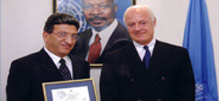Najib Saab, issue 242, May 2018
According to a report recently released by the United Nations Environment Program (UNEP), the Frankfurt School of Finance and Bloomberg, the sun has become the most attractive source for new investments in global energy production. Investments in solar energy reached $161 billion last year, producing 98 gigawatts of electricity. This goes far beyond any other source, including coal, gas, oil and nuclear power. It is also worth noting that most of the increase occurred in China, which alone exceeded half the investments in new energy.
The production capacity of renewable energy projects launched last year, especially sun and wind, reached 157 gigawatts, compared to only 70 gigawatts from all other sources combined. As the cost of producing electricity from solar panels and wind turbines continues to decline, every dollar invested today yields an additional 25 to 75 percent return in kilowatts, compared to five years ago. This is an explicit indicator of future energy production trends.
The International Renewable Energy Agency (IRENA), based in Abu Dhabi, expects that by 2020 the cost of producing electricity from renewable energy will be the cheapest, compared to any other traditional source around the world.
Where do Arab countries stand in view of these developments, which are happening at a rapid pace that took most observers by surprise?
The past few weeks have shown strong signs that many Arab countries are not far from these developments. As part of the implementation plans of its "Vision 2030", Saudi Arabia signed an agreement with Softbank, a colossal Japanese investment fund for high technology projects around the world, to produce 200 gigawatts of solar power by 2030. This is 2.5 times the current total production of electricity in Saudi Arabia, and 100 times more than the largest project announced in the world. The cost of construction is about $200 billion, which comes mostly from commercial investments, covering the cost of setting up solar panel factories, solar farms and distribution networks. By comparison, the world's largest single solar power plant is currently producing 1.5 gigawatts.
Very recently, Saudi Arabia's ACWA Power signed a contract with Shanghai Electric Generation Group, to execute a project for Dubai Electricity and Water Authority, entailing the production of 700 megawatts of electricity in Dubai. The project constitutes the fourth phase of the Mohammed Bin Rashid Al Maktoum Solar Power Complex in Dubai, which announced plans to produce 75 percent of its electricity needs from renewable sources by 2050.
The Noor project in Morocco ranked first in the world in terms of investment in solar energy in the first quarter of 2018, according to a report issued by Bloomberg New Energy International. The last part of the Noor solar complex in Ouarzazate has attracted investments from both domestic and foreign sources worth $2.4 billion. Investments in the four phases of the solar complex amounted to $9 billion, with a capacity of 2000 megawatts (2 gigawatts). It is also implemented by Saudi Arabia's ACWA Power, and mostly financed by commercial financial institutions and the World Bank.
The key lesson from these developments is that renewable energy has become an integral component of the energy mix and will become, in a few years, the main source of electricity production around the world. It is no longer dependent on subsidies, but has become a strong commercial competitor to coal, gas, oil and nuclear power; in fact cheaper in many areas. Renewable energy projects today attract private sector investments, due to its generous returns. It is true that climate change mitigation measures have led to the rapid development of renewable energy technologies and applications in the first place, but these have gained their own momentum now, regardless of climate agreements. This is simply because they proved commercially viable, and solid competitors to conventional sources.
It is essential that all Arab countries respond to these transformations, because change is moving rapidly, otherwise they will be left behind.
Who said that the rational management of natural resources contradicts economic realities?
|




